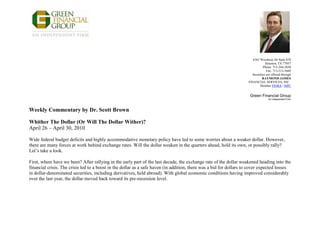
Whither The Dollar (Or Will The Dollar Wither)?
- 1. 6363 Woodway Dr Suite 870 Houston, TX 77057 Phone: 713-244-3030 Fax: 713-513-5669 Securities are offered through RAYMOND JAMES FINANCIAL SERVICES, INC. Member FINRA / SIPC Green Financial Group An Independent Firm Weekly Commentary by Dr. Scott Brown Whither The Dollar (Or Will The Dollar Wither)? April 26 – April 30, 2010 Wide federal budget deficits and highly accommodative monetary policy have led to some worries about a weaker dollar. However, there are many forces at work behind exchange rates. Will the dollar weaken in the quarters ahead, hold its own, or possibly rally? Let’s take a look. First, where have we been? After rallying in the early part of the last decade, the exchange rate of the dollar weakened heading into the financial crisis. The crisis led to a boost in the dollar as a safe haven (in addition, there was a bid for dollars to cover expected losses in dollar-denominated securities, including derivatives, held abroad). With global economic conditions having improved considerably over the last year, the dollar moved back toward its pre-recession level.
- 2. The exchange rate of the dollar is a price, determined by supply and demand. Trade and capital flows in and out of the United States
- 3. are huge. In the U.S., we have a net trade outflow and a net capital inflow – and these two theoretically balance (the dollar moves to equate the two). The current account deficit (which is mostly the trade deficit in goods and services) has a significant long-term impact on the dollar. The rise in the current account deficit in the last decade meant that the U.S. had to attract more net capital inflows to keep the dollar stable. The current account deficit peaked at 6.5% of GDP in 4Q05. The softer dollar resulted in some increase in imported inflation, but also dampened imports and made U.S. exports more competitive. The current account deficit had been improving ahead of the global financial crisis, but that improvement accelerated sharply as the global economy weakened. As a consequence, the U.S. needs smaller net capital inflows than it did before the crisis to keep the dollar steady. The current account deficit is now widening again – a long-term negative for the dollar. Over the intermediate term (less than two years) relative growth prospects matter a lot. The U.S economic recovery is expected to be stronger than that of the United Kingdom and Europe. The IMF expects 2.8% GDP growth (4Q-over-4Q) for the U.S. in 2010 and 2.4% in 2011. In contrast, the IMF expects 1.2% growth in the Euro Area in 2010 and 1.8% in 2011. Growth in the UK is expected at 2.3% in 2010 and 2.6% in 2011. However, the upcoming election (May 6) in the UK, further sovereign debt worries in Europe (Spain, Portugal), and fiscal policy uncertainty in the U.S. cloud the relative growth outlook. What about the U.S. federal budget deficit? As mentioned in previous missives, the large U.S. deficit is a function of the recession and two large temporary spending programs. The deficit should decrease as tax revenues pick up. However, the decrease in the fiscal stimulus into 2011 will act as a drag on economic growth. The Bush tax cuts are set to sunset at the end of the year. Raising taxes is not a good idea in a fledging economic expansion. Postponing those tax increases would be a good idea, but that would require a bipartisan effort. In the short term, central bank policies are a major factor in exchange rates. The U.S. Federal Reserve is on hold for an extended period. Foreign central banks may be itching to hike, but should be reluctant to move until inflation appears as a more credible threat. However, the Fed is more likely to raise later, perhaps putting some downward pressure on the dollar. Worries about the UK and Europe will provide some support for the dollar in the near term. In the Great White North, the strong Canadian dollar poses a dilemma, for Canada’s economy depends on exports to the U.S. – and a weaker economy would push its currency down again. The Chinese appear likely to let the renminbi appreciate, but don’t expect much. In short, there are a lot of uncertainties in the dollar outlook, but a large move in either direction seems unlikely for now
